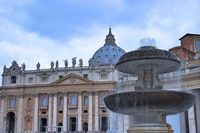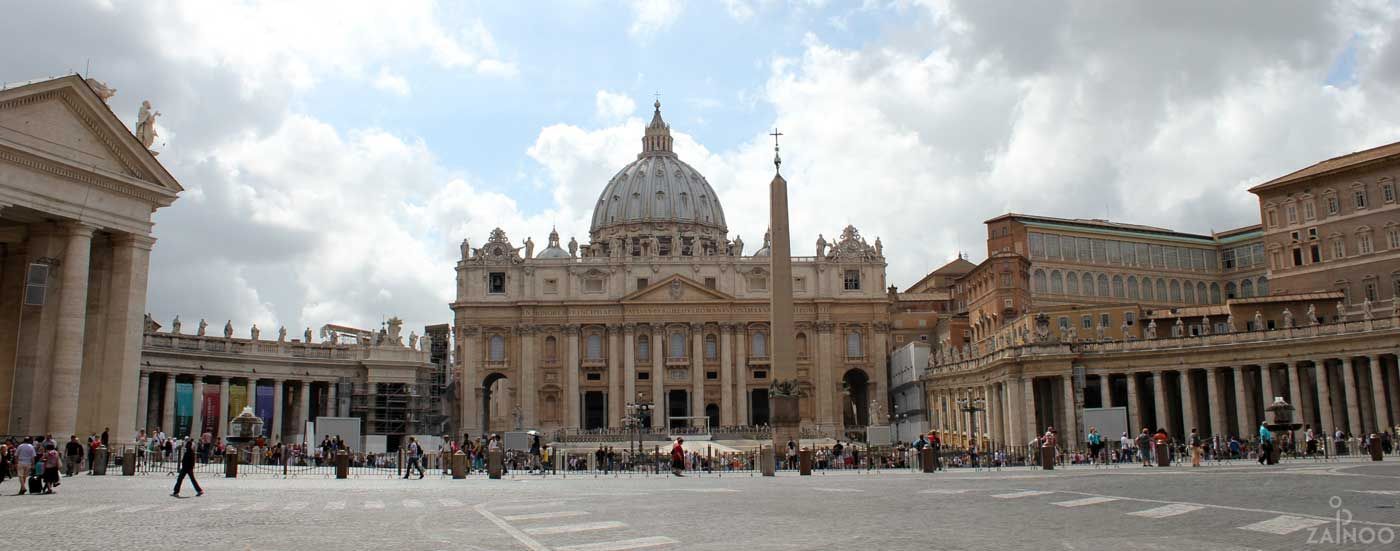St. Peter's Basilica
Cathedral
San Pietro in Vaticano - St. Peter's Basilica
The most famous church in Christendom
St. Peter's Basilica in the Vatican is the most famous church in Christendom and was built in the beginning of the 4th Century A.D. It is dedicated to the apostle Peter, who – according to archaeological research and records – was martyred here in A.D. 67. The first St. Peter's Church, which was also built directly over the grave of the apostle, was an early Christian, five-nave Basilica, which was close to decay after the return of the popes from Avignon. In 1506, Pope Julius II decided to reconstruct the Basilica, which lasted more than 250 years until the reign of Pope Pius VI. The most famous and celebrated architects and builders of that time were involved: Bramante, Raphael, Giuliano da Sangallo, Baldassare Peruzzi, Fra Giocondo, Maderno and finally Michelangelo, who completed the St. Peter's Basilica with its mighty dome, designed by himself, in 1564 after the basic plans of Bramante - a basilica with a Latin cross plan.
Exterior façade and entrance hall
The monumental façade of the cathedral is 115 metres long and 45.5 metres high. The unusual length of the façade is based on the request of Pope Paul V, who wanted to connect the St. Peter's Basilica to the Vatican Palace. Maderno created the façade with great columns, pillars, balconies, windows and entrances. From the central loggia, the senior cardinal deacon proclaims the name of the new pope. Moreover, the Pope gives his blessing from here to the believers at St. Peter's Square. On the façade there are statues nearly six metres tall of Christ, John the Baptist and the apostles except Peter. The entrance hall is flanked inside by two equestrian statues - Charlemagne and Constantine. The mosaic ceiling in the middle portal is by Giotto. Together with the mighty bronze doors, it was taken over from the old St. Peter's Church.
In the interior of St. Peter's Basilica: right aisle
186 metres long and with a height of 119 metres in the dome area, the mighty Basilica is impressive inside and of gigantic proportions. Many chapels, altars, tombs, ceremonial plates, art objects and rich ornaments make the tour a unique experience. Right next to the main entrance, a plate marks the place where Charlemagne was crowned Emperor of the Roman Empire by Pope Leo III. In the first chapel on the right, the Cappella della Pietà, there is one of the first highlights of the Cathedral: The unique Pietà by Michelangelo. The almost perfect marble statue was created by the artist for the grave statue of Cardinal Jean de La Bilhères Groslaye. On the first side pillar there is a memorial plate to Queen Christina of Sweden, who renounced her throne to convert to Catholicism. Right at the very next pillar is the Mausoleum of the Countess Matilda of Tuscany, which was designed by Bernini. On the right side you can now see the Blessed Sacrament Chapel of Pope Urban VIII, which was built by both Bernini and Borromini. Right behind is the Gregorian Chapel with the monument of Pope Gregory XIII, to whose reforms we owe our current Gregorian calendar. The neoclassical tomb of Pope Clement XIII was created by the young Antonio Canova.
Papal altar and bronze figure of seated St. Peter
The papal altar in the centre of St. Peter's Basilica is located right over the grave of St. Peter. It was designed by Bernini in 1633 for Pope Urban VIII and is crowned by a 29 metre tall bronze baldachin. Bernini created here a masterpiece of the Baroque. The prayer room in front of Peter's grave is illuminated by 95 gilded oil lamps, where the eternal flame burns. On the right pillar in front of the papal altar stands the bronze statue of St. Peter. His right foot is already quite flattened because touching it is supposed to bless you.
Apse and left aisle
In baroque light drama the Cathedra Petri in the apse was created by Bernini. The four teachers of the Church, Augustine, Ambrose, Athanasius and John Chrysostom support here the episcopal throne of Peter, on whose back the papal symbols "Key and Tiara" are attached. The throne itself belonged to Charles the Bald in the 11th Century, before it came to Rome. Over the episcopal throne of Peter there is an alabaster window in a glory of rays gilded from stucco in which the dove of the Holy Spirit is brightly lit by daylight.
The tomb of Pope Urban VIII right next to the apse was also created by Bernini. The grave of Pope Paul III was created by Guglielmo della Porta. The tomb of Pope Alexander VII is also likely to have been created by Bernini. The large monument of Pius VII is the only one designed by a Protestant artist - Thorvaldsen. In front of the choir chapel hangs the mosaic copy of the "Transfiguration" by Raphael - the original can be seen in the Vatican Museums. The tomb of Pope Innocent VIII, before the Cappella della Presentazione, is the only one that has been taken from the old St. Peter's Church.
Dome and roof of St. Peter's Basilica
The massive dome can be reached by a separate entrance, right next to St. Peter's Basilica. You have the choice to go up with the elevator to the inner dome, or walk up the arduous path for a reduced price on foot. From the gallery in the tambour ring, you look down at the papal altar. 2-metre tall Latin letters, spelling out the phrase from the Gospel of Matthew upon which Papal authority was founded, adorn the dome ring ("You are Peter and upon this rock I will build my church and I grant you the keys of the kingdom of heaven"). Over another 330 steps, you reach the roof of the Basilica in the dome. From here you have a magnificent view over St. Peter's Square and over all of Rome!
Sacre Grotte Vaticane and necropolises
To the right of St. Peter’s Basilica is the entrance to the Vatican Grottoes. Except Pope Innocent VIII, all the popes from the old St. Peter's Church and many subsequent popes are buried here. With a written reservation (www.pilgerzentrum.de) at the Ufficio Scavi di San Pietro, you can also join a two-hour guided tour of the necropolis under St. Peter's Basilica. The old necropolis also houses the tomb of St. Peter.
Entrance
Climb to the dome:
by foot: € 5,-
by elevator: € 7,-















Tweet